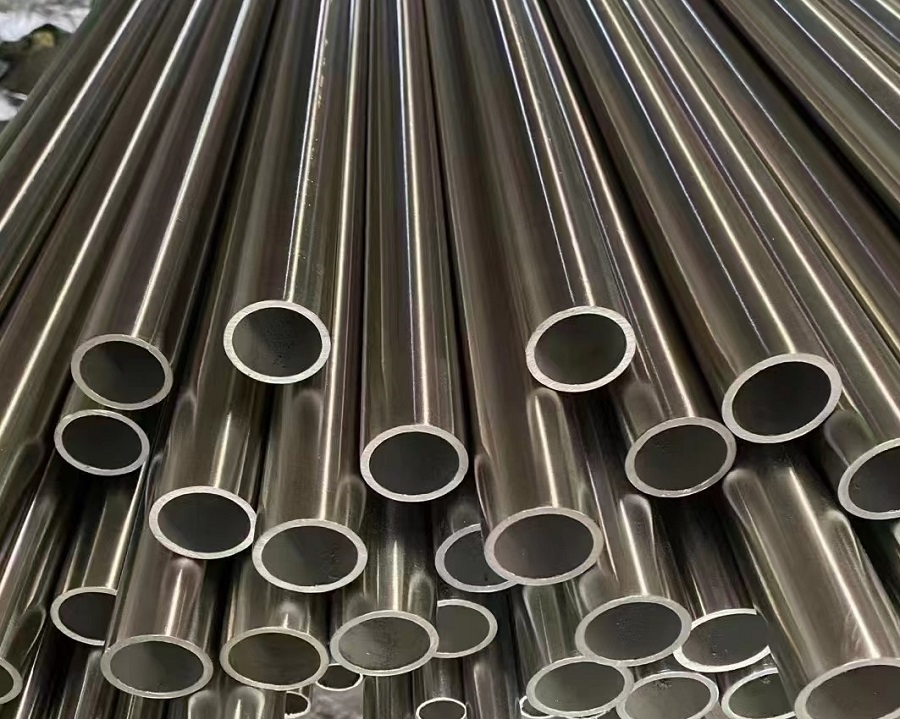ASTM B622 C276 is a specification for seamless nickelmolybdenumchromiumtungsten alloy (UNS N10276) tubing. The Alloy C276 is known for its excellent corrosion resistance and is widely used in various applications due to its ability to withstand extreme environments. ASTM B622 is a specification standard developed by ASTM International that covers seamless nickelchromiumironmolybdenumcopper alloy (UNS N10276) tubes. UNS N10276 is a highperformance, corrosionresistant nickelmolybdenumchromium alloy known as
Hastelloy C276. This alloy is widely used in various industries, particularly in environments where corrosion resistance is critical.
1. ASTM B622 C276 Tube Composition:
Nickel (Ni): Balances the alloy and provides exceptional corrosion resistance.
Chromium (Cr): Enhances corrosion resistance and oxidation resistance.
Molybdenum (Mo): Contributes to resistance against pitting and crevice corrosion.
Columbium (Nb): Improves stability and resistance to sensitization.
Nickel (Ni): Balancing element
Chromium (Cr): 14.516.5%
Molybdenum (Mo): 1517%
Iron (Fe): 47%
Tungsten (W): 34.5%
Cobalt (Co): 2.5% max
Manganese (Mn): 1% max
Vanadium (V): 0.35% max
Sulfur (S): 0.03% max
Carbon (C): 0.01% max
Silicon (Si): 0.08% max
Phosphorus (P): 0.04% max
|
Element
|
Composition (%)
|
|
Nickel (Ni)
|
Balance
|
|
Chromium (Cr)
|
14.5 16.5
|
|
Molybdenum (Mo)
|
15.0 17.0
|
|
Iron (Fe)
|
4.0 7.0
|
|
Tungsten (W)
|
3.0 4.5
|
|
Cobalt (Co)
|
2.5 max
|
|
Manganese (Mn)
|
1.0 max
|
|
Vanadium (V)
|
0.35 max
|
|
Silicon (Si)
|
0.08 max
|
|
Carbon (C)
|
0.01 max
|
|
Phosphorus (P)
|
0.04 max
|
|
Sulfur (S)
|
0.03 max
|
2. ASTM B622 C276 Tube Mechanical Properties:
Tensile Strength: Minimum of 100 ksi (690 MPa).
Yield Strength: Minimum of 41 ksi (283 MPa).
Elongation: Minimum of 40%.
|
Property
|
Value
|
|
Tensile Strength, min
|
100 ksi (690 MPa)
|
|
Yield Strength (0.2% offset), min
|
41 ksi (283 MPa)
|
|
Elongation, min
|
40%
|
|
Hardness (Brinell)
|
210 HB max
|
|
Hardness (Rockwell B)
|
93 HRB max
|
3. ASTM B622 C276 Tube Form:
Seamless tubes: Produced without longitudinal welds, ensuring reliability in highpressure and corrosive environments.
4. ASTM B622 C276 Tube Dimensions and Tolerances:
Dimensions: The standard covers tubes with outside diameters ranging from 0.125 inches (3.18 mm) to 2.5 inches (63.5 mm) and wall thicknesses from 0.015 inches (0.41 mm) to 0.135 inches (3.43 mm).
Lengths: Tubes can be supplied in lengths up to 42 feet.
Adheres to ASTM B622 specifications for outer diameter, wall thickness, and length with defined tolerances.
5. ASTM B622 C276 Tube Heat Treatment:
Guidelines provided for heat treatment to achieve desired mechanical and corrosionresistant properties.
Tubes are typically supplied in the solutionannealed condition.
6. ASTM B622 C276 Tube Testing and Inspection:
Undergoes various tests such as hydrostatic, tension, and hardness tests to ensure quality and reliability.
The tubes undergo various tests such as hydrostatic or nondestructive electric tests, and they must conform to the specified mechanical properties.
7. ASTM B622 C276 Tube Surface Finish:
7.1. Pickled and Annealed Finish:This finish involves pickling the tubes to remove any scale or impurities on the surface, followed by annealing to improve corrosion resistance and restore mechanical properties. It leaves the tubes with a clean and smooth surface suitable for many applications.
7.2. Mechanical Polish:Mechanical polishing involves using abrasive materials to remove surface imperfections and create a smooth, reflective finish on the tubes. This finish is often chosen for applications where hygiene, aesthetics, or improved corrosion resistance are important.
7.3. Electropolished Finish:Electropolishing is an electrochemical process that removes a thin layer of material from the tube surface, resulting in a smooth, bright finish with enhanced corrosion resistance and cleanability. It is commonly used in industries such as pharmaceuticals, food processing, and semiconductor manufacturing.
7.4. Mill Finish:Some applications may require tubes to be supplied with a mill finish, which is the untreated surface straight from the manufacturing process. While this finish may have visible surface imperfections, it is suitable for applications where aesthetics are not a primary concern, or where further finishing processes will be applied by the enduser.
8. ASTM B622 C276 Tube Application:
Suited for diverse industries, including chemical processing, petrochemical, pollution control, and power generation where corrosion resistance and highstrength characteristics are paramount.
8.1. Chemical Processing: Due to its outstanding resistance to a wide range of chemicals, including sulfuric, hydrochloric, and hydrofluoric acids, C276 tubing is commonly used in chemical processing plants.
8.2. Petrochemical and Refining: The tubing is utilized in the petrochemical and refining industries, where it can handle the corrosive substances and high temperatures encountered in these environments.
8.3. Pharmaceuticals: In the pharmaceutical industry, the tubing is used in systems that require high purity and resistance to corrosion, ensuring the integrity of the products being manufactured.
8.4. Waste Treatment: C276 tubing is employed in waste treatment facilities where it can resist the corrosive nature of waste byproducts and chemicals used in treatment processes.
8.5. Marine Applications: The alloy’s resistance to seawater corrosion makes it suitable for use in marine environments, including offshore oil and gas platforms, and other marine structures.
8.6. Pulp and Paper Industry: The tubing is used in the pulp and paper industry where it can withstand the corrosive chemicals and high temperatures used in the production processes.
8.7. Pollution Control: C276 tubing is used in flue gas desulfurization systems and other pollution control equipment, which require materials that can resist acidic and oxidizing environments.
8.8. Heat Exchangers: Due to its high thermal conductivity and corrosion resistance, C276 tubing is ideal for use in heat exchangers in various industries.
8.9. Nuclear Power Plants: The tubing is used in nuclear reactors and associated systems where materials need to withstand high radiation and corrosive environments.
9. Advantages of ASTM B622 C276/UNS N10276 Tube:
Excellent corrosion resistance in a wide range of aggressive environments.
Versatility for use in applications with high temperatures, strong acids, and harsh chemical environments.
Reliable performance in challenging industrial conditions.
10. ASTM B622 C276 Tube Physical Properties:
Density: 8.89 g/cm³
Melting Range: 13251370°C
11. ASTM B622 C276 Tube Compliance:
Meets ASTM B622 standards, ensuring consistent quality and performance.
ASTM B622 C276/UNS N10276 tubes stand as a paramount choice for industries necessitating robust corrosion resistance and mechanical strength in challenging environments. These tubes offer exceptional corrosion resistance against a wide array of aggressive media, including oxidizers, acids, and chlorides, while demonstrating resilience against pitting, crevice corrosion, and stress corrosion cracking. With hightemperature stability, excellent ductility, and toughness, they ensure reliable performance in severe conditions. Their compliance with ASTM B622 standards guarantees quality and consistency, making them ideal for critical applications such as heat exchangers, pressure vessels, and piping systems in chemical processing, oil and gas, and marine industries, where longevity, low maintenance, and longterm reliability are paramount.
ASTM B622 C276 Tube|ASTM B622 UNS N10276 Tube









